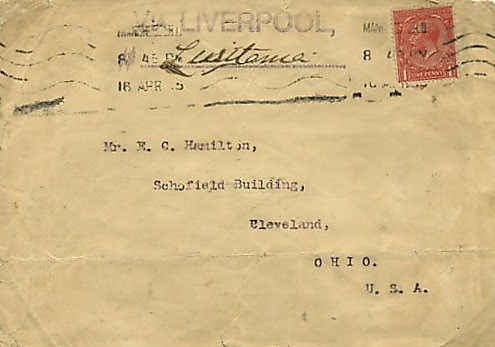Discovery of RMS Lusitania
The RMS Lusitania Medal - Karl Goetz
In August 1915, several months after the sinking of the Lusitania, Karl Goetz produced his first version of the “Lusitania medal”. His first medal, shown below, had an incorrect date (5 May 1915) but he corrected in a later edition. The British copied the medal and used it for propaganda purposes during the First World War.

The loss of the Lusitania provoked great outrage in the United States and became a factor in them joining the war. It was even suggested by an American Congressman, Richmond Hobson that the British Government had sunk the ship to entice America into the war.
Following the sinking, as with HMHS Britannic, many questions were asked. In the summer of 1993, Dr. Robert Ballard set out on a quest to locate the wreck, explore it and try to answer those questions.
He suspected that “illegal high explosives in the ships magazine had probably caused the tragedy.” To him, it made perfect sense that after the torpedo hit the starboard side of the ship, the explosion ignited the arms and explosives stacked in the ship’s magazine to cause a second explosion internally.
He did however, have problems with how witnesses had recalled the position of the impact. Many eyewitnesses had stated that the torpedo hit below or just in front of the Bridge. If it did, the magazine would have been too far away to have been hit (the bulkheads were in the way). Did the boilers explode in this case? Often as a ship sinks, cold water pours over the extremely hot boilers and makes them explode. It was a possibility.
Dr. Ballard saw that the Lusitania lay on her starboard side in 295 feet of water along a bearing of about 230º. The great hull had been torn open during the sinking and is in two torn and twisted pieces.
Sonar images showed a fracture running between the 3rd and 4th funnel. The structural damage seemed to bear a resemblance to where the Titanic's damage occurred where the huge First Class Dining Room and First Class Lounge were located. The wreck has many holes presumably caused by depth charges and it is covered with fishing nets which hindered Dr Ballard’s progress.
Much of the remote exploration was done by Jason Junior, the 3000lb ROV (remotely operated vehicle) used during the exploration of the Titanic. By using modern 3D imaging systems, they were able to superimpose a picture of the great ship in her prime over a 3D image of the wreck computed from sonar signals to see the areas most affected by the sinking.
Jason Junior was manoeuvred to the portside of the hull, where a previous diver, John Light had reported where the main damage was caused by the second explosion. Dr. Ballard could not see the hole. The exploration continued and he wanted to dive closer to the wreck in his submarine Delta. They had to be careful not to get caught up in fishing nets. They came across some of the ship's distinctive vents, a boat winch, floor tiles and the ships whistle etc. a typical debris field.
As with the Britannic and the Titanic, the bow was bent upwards. This was caused by the great impact as she hit the bottom.
The Foredeck is covered with fishing nets but the windless brake, small crane and a section of the great anchor chain remains intact. There was even rope around a bollard.
Once Dr. Ballard had photographed the wreck, he turned his attention to what actually sank her. He explored the total area of the magazine and he determined that it did not explode and was still intact. The second explosion could not be attributable to the magazine exploding.
Dr. Ballard concluded that if the torpedo had struck beneath the Bridge, it would have hit the coalbunkers. The ship’s coal bunkers would be nearly depleted and full of coal dust. Sparks from the torpedo could have ignited the unsettled coal dust causing a huge explosion sufficient to cause enormous damage to the hull. Within minutes, the ship would have developed a severe list to Starboard causing her to sink.Discovery of RMS Lusitania

